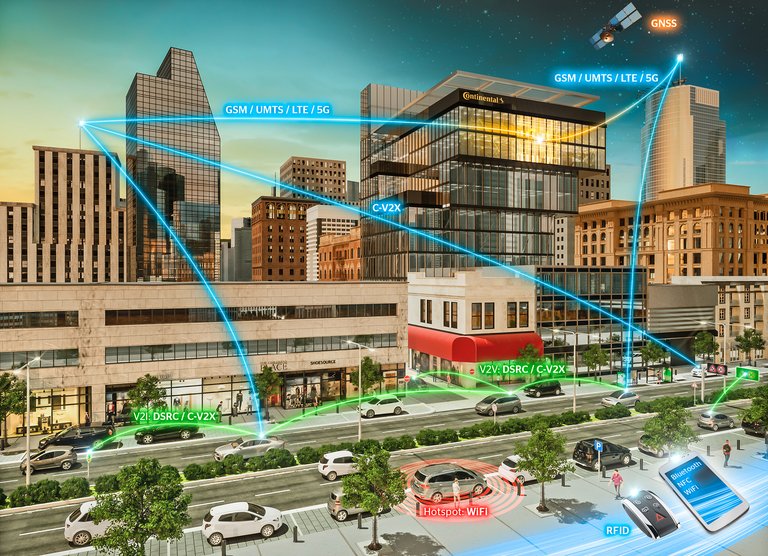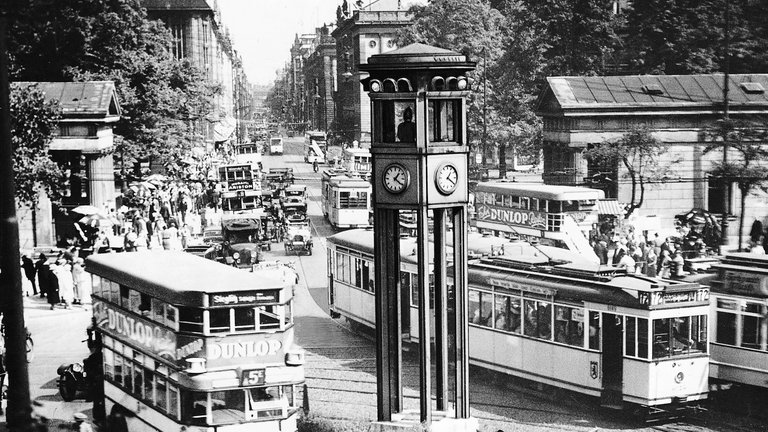Urban Mobility Trends and Smart Traffic Management
On August 5, 1914, the first electric traffic light was put into operation in Cleveland, Ohio, marking a milestone in traffic control. Red, yellow and green have been elementary signals on roads ever since – a fact commemorated by International Traffic Light Day. Traffic lights remain as indispensable as ever, especially in cities. Modern systems continue to rely on traffic lights as the most important means of managing traffic. But as the number of automated vehicles on roads increases, what will the future traffic lights look like? And which complementary systems will come into play to ensure safety and control traffic flow?
Urban Mobility Trends
Private transportation gained considerable importance during the coronavirus pandemic. This was one of the key findings of Continental’s Mobility Study 2022, for which 6,000 people from around the world were surveyed by market and social research institute infas. The vast majority reported using their car at least once a week. In the USA, more than half (59 percent) even used theirs every day.
According to the study, cars were expected to maintain their prominent position and continue to be people’s most important means of mobility. A vast majority of those who reported having traveled during the pandemic asserted in the survey that they intended to continue either using their car just as much (84 percent) or even more (60 percent) once the pandemic was over.
A majority of people in Germany regarded cars as an essential part of their mobility and their personal living space. Here, there was a strong desire to have the latest technologies in their vehicle. A majority, for example, wanted their car to be connected to the internet in order to download the latest software as well as traffic and environmental information, the mobility study reports. Half of the respondents saw electronic assistance systems as desirable or even as necessary basic equipment.
Data infrastructure needs to be expanded
In order to meet these demands, the technological transport and data infrastructure will need to be expanded. Only in this way will it be possible for technology – both inside and outside of the vehicle – to unlock its potential.
Traffic lights are reaching their limits
Traffic lights have played an important role worldwide ever since they were first introduced more than 100 years ago: they enhance road safety outside of the vehicle, yet at the same time they are also increasingly reaching their limits and producing traffic jams in major cities.
Road safety
Today, more than half of the world’s population lives in cities. With the United Nations (UN) expecting the population to reach 8.5 billion people by 2030, the already excessive traffic in built-up areas will be exacerbated even further. Hence, road safety is set to become a major challenge in the next decade.
Improving traffic flow
Technological innovations provide a basis for improving traffic flow through automation and connectivity. A steady flow of traffic is an often underestimated yet decisive factor when it comes to ensuring safe as well as lower-emission mobility.
Connectivity and Communication – Solutions for Smart Traffic Management
Continental has the right technologies for the demands and connectivity of the traffic of tomorrow – including cameras, radar, lidar, as well as software and hardware for connectivity and automated driving.
For Continental, there is no way around so-called “car-to-X technology,” in which vehicles communicate with surrounding infrastructures. The car of the future is not a closed system, but part of an ecosystem. Currently, however, only five percent of vehicles are interconnected. According to experts, almost one-fifth of new vehicles will be equipped with the technology needed to communicate with other vehicles and infrastructure by 2028.
Urban hubs are sort of the pinnacle of city traffic planning. Here, various forms of transport come together at varying speeds. The concept behind an “intelligent intersection” is that it provides a complete image of the environment and shares valuable information with connected vehicles.
One challenge here is that a major city can have 1,000 or more intersections, not all of which can be retrofitted. In addition, movement profiles of pedestrians will need to be improved, as will the means of counting traffic.
The intelligent intersection is a good example of a wide range of technologies meshing together, and is a further step on the journey toward Vision Zero – a world of accident-free driving. In the USA, Continental is working toward this goal together with partners such as Iteris, a leading global supplier with a focus on intelligent mobility infrastructure management.
In Japan, Continental has been putting the concept of an intelligent intersection into practice as part of a pilot project since July 20, 2022. To this end, Continental has been using its own traffic flow monitoring system. The aim of the project is to reduce the number of traffic accidents in the vicinity of the intersection over the long term.
In Iași, the fourth largest city in Romania, Continental is implementing a further pilot project together with its partners in the spring of 2023. One of the city’s busiest traffic intersections is being equipped with Continental sensor systems in order to gain further insights into the behavior of different road users. The intelligent intersection in Iași is to be developed further on the basis of 5G technology.
Continental’s first intelligent intersection was also tested under everyday conditions; this was back in 2017 in Columbus, Ohio. The intelligent intersection is equipped at key points with lidar, radar and camera sensors. High-performance algorithms create a detailed image of the environment – at any time of day, and even during adverse weather conditions. The system recognizes every road user in a 360° radius. It transmits the position and movement of relevant objects to all vehicles in range that are equipped with the relevant technology. Data is exchanged between the intersection and connected vehicles – to warn drivers of cyclists who may be in the driver’s blind spot, for example – via mobile communications networks, taking just a few milliseconds.
Another example of how this can be used is the “digital guardian angel” for vulnerable road users: the collision warning system aimed at protecting vulnerable road users is being tested in Hamburg as part of a mobility partnership with Deutsche Telekom. With the help of “mobile edge computing,” a cloud-based calculation of potential collisions with cyclists, pedestrians and e-scooters takes place at critical intersection areas. In this process, the road users receive hazard warnings via mobile communications networks. They are able to communicate with one another virtually in real time.
The intelligent intersection pilot project is just the beginning. If safety really is to be increased at these accident hotspots, sustained investment in intelligent infrastructure is needed.
August 5: International Traffic Light Day
- Today, traffic lights are an integral part of city landscapes worldwide. Where police officers once stood and controlled the flow of traffic at intersections using hand gestures or other means of signaling, traffic lights have now been used to ensure road safety for over 100 years.
- Traffic lights are thought to have prevented millions of accidents and saved thousands of lives. All traffic lights work – with some exceptions – according to the same principle: red to mean stop, green to mean go, and yellow to mean that the lights are about to change. So it follows on from this that traffic technology can only ensure safety if reliable standards are in place. At the same time, it must itself be both safe and reliable.
- Traffic lights are resolvers of conflict. The interplay of colors and coordination between the traffic lights ensures that all road users can not only get around safely, but also as smoothly as possible, by road or on the tram, on cycling paths or footpaths.
- On August 5, 1914, which is commemorated by the annual International Traffic Light Day, the first electric traffic light was put into operation in Cleveland, Ohio, marking a milestone in traffic control that has now stood the test of time for over a century. The traffic light system initially only used the colors red and green. The first traffic lights using three colors were introduced in New York and Detroit in 1920.
- In Germany, traffic lights were first used on Hamburg’s Stephansplatz in 1922. A well-known set of traffic lights are those commissioned by Siemens on Potsdamer Platz in 1924 – which, according to Siemens, was the busiest square in Europe at that time.
- According to estimates by traffic light manufacturer Siemens, there are currently around 1.5 million traffic lights in Germany, with every second set of traffic lights having come from this manufacturer.
- Thanks to modern technology, traffic lights have since become more energy-efficient (LEDs), but also more intelligent: traffic control via sensors, cameras and central computers takes into account the current traffic situation and optimizes the flow of traffic, for example through the use of “green waves,” or prioritizes emergency vehicles, buses and trams.
- Fun fact: Every driver in Germany will spend around two weeks of their life waiting at red lights. The psychological “limit” for a red light is 120 seconds. Any longer than this will lead to annoyance and mistrust: pedestrians will set off while the light is red, and cyclists and drivers will wait a moment longer before also starting to move. In such a scenario, traffic lights no longer contribute to conflict resolution.
(Status: April 2023)







